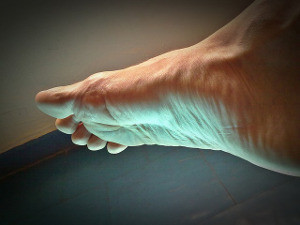You Can Enjoy Pain Free Living From Home
Author: Julie Donnelly, LMT –The Pain Relief Expert
Editor: Dr. Steve Chaney
 Recently a woman came in to see me who was suffering from severe plantar fasciitis pain, her arch hurt so much she could barely walk. She’d been to several specialists and has so far bought three pair of orthotics (at $400 each!). Plantar fasciitis is getting to be a commonplace condition in my office. I love working with athletes, but I’m finding this isn’t only a problem for athletes.
Recently a woman came in to see me who was suffering from severe plantar fasciitis pain, her arch hurt so much she could barely walk. She’d been to several specialists and has so far bought three pair of orthotics (at $400 each!). Plantar fasciitis is getting to be a commonplace condition in my office. I love working with athletes, but I’m finding this isn’t only a problem for athletes.
Because of driving a car for long distances her right foot was worse than her left, which makes sense since the muscles that enable you to press down on the gas and brake pedals, are the same ones that are the cause of plantar fasciitis.
Plantar Fasciitis Causes: Are Muscles The Culprit?
Muscles are seldom considered when searching for the answer to plantar fasciitis pain. Instead the foot is considered to be the problem, instead of the symptom, and orthotics are commonly recommended. In many cases, when muscles are the cause of the plantar fasciitis symptoms, the orthotics will cause more pain.
The analogy I always use is, if you pull your hair at the end, your scalp will hurt. But you don’t need to massage your scalp, you don’t need to take pain-killers for the headache, and you don’t need brain surgery — you just need to let go of your hair! It’s the same with joint pain. Muscles pull on tendons, and the tendons insert into a joint. When the muscle is tight you will feel the pain at the joint. But you don’t need to rub the joint, or take pain-killers, or have surgery—you need to release the spasms in the muscle fibers.
In the case of plantar fasciitis, the muscles are in your lower leg, and the insertion of the tendon is in your arch – so when the muscles are tight your arch will hurt.
The two muscles are the tibialis anterior and the peroneal. The tibialis anterior runs along the entire length of the shin bone and then the tendon inserts onto the first metatarsal (the long bone that is on the inside of your arch and goes up to your big toe), while the peroneal runs along the entire outside of your lower leg, goes behind your ankle, and the tendon inserts on the fifth metatarsal (the bone on the outside of your foot) and also on the first metatarsal at the same point as the insertion of your tibialis anterior. This is important to visualize so you can see how the tendons pulling on the bones will put pressure on your arch and cause the arch muscles to be strained — causing plantar fasciitis pain in the bottom of your foot.
Self-Treatment For Plantar Fasciitis Pain
 There are several muscles that all impact your arch and cause the pain of plantar fasciitis. This picture is doing the treatment for the muscle that runs down the outside of your lower leg, called peroneal. The peroneal is neglected by most therapists when searching for an answer to foot pain, yet it is often one of the key muscles that needs to be treated to get relief.
There are several muscles that all impact your arch and cause the pain of plantar fasciitis. This picture is doing the treatment for the muscle that runs down the outside of your lower leg, called peroneal. The peroneal is neglected by most therapists when searching for an answer to foot pain, yet it is often one of the key muscles that needs to be treated to get relief.
Sit as shown in the picture and use either the Julstro Perfect Ball, or a new tennis ball, and press the outside of your leg directly onto the ball. You’ll find a very tender point at the same level as shown in this picture.
When you find it, hold the pressure steady, and then slightly move your leg so the ball rolls up and down the outside of your leg. Use your hand as shown to press down on your leg to increase the pressure.
You’ll be thrilled when you see how quickly you’ll feel relief! You’ll be able to go back out and enjoy your life pain-free!
Plantar fasciitis causes are often centered around muscles in the legs, therefore plantar fasciitis pain relief is also.
Wishing you well,
Julie Donnelly
About The Author
Julie Donnelly is a Deep Muscle Massage Therapist with 20 years of experience specializing in the treatment of chronic joint pain and sports injuries. She has worked extensively with elite athletes and patients who have been unsuccessful at finding relief through the more conventional therapies.
She has been widely published, both on – and off – line, in magazines, newsletters, and newspapers around the country. She is also often chosen to speak at national conventions, medical schools, and health facilities nationwide.
These statements have not been evaluated by the Food and Drug Administration. This information is not intended to diagnose, treat, cure or prevent any disease.
Check It Out!
If you would like easy to follow instructions on how to relieve joint pain and muscle tightness from head to toe click here (http://www.triggerpointyoga.com/product/triggerpoint-yoga-full-body-kit/?ap_id=SteveChaneyTips) to check out Julie Donnelly’s Trigger Point Yoga instruction kit today. Whenever, I have pain and stiffness I use her techniques. They work!

